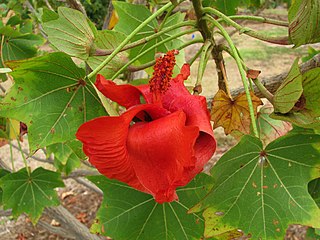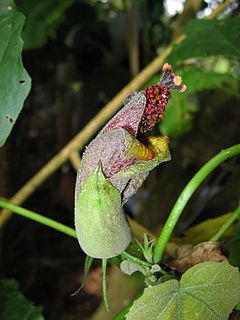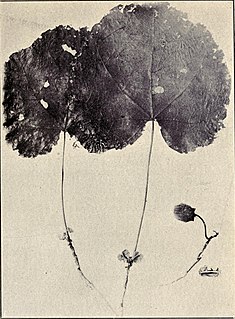
Hibiscadelphus is a genus of flowering plants that are endemic to Hawaiʻi. It is known by the Native Hawaiians as hau kuahiwi which means "mountain Hibiscus". The Latin name Hibiscadelphus means "brother of Hibiscus". It is distinctive for its peculiar flowers, which do not fully open. Hibiscadelphus is in the family Malvaceae, subfamily Malvoideae. Several of the species in this small genus are presumed extinct.

Hibiscadelphus distans is an extremely rare species of flowering plant in the mallow family, Malvaceae, that is endemic to the island of Kauaʻi in Hawaii. It is known as hau kuahiwi in Hawaiian, which means "upland Hibiscus tiliaceus." It is a bush or small tree with heart-shaped leaves and yellow flowers and grows at between 1,000 and 1,800 feet in the remnants of native dry forests. Despite its rarity, it is believed to be the only surviving species in the genus Hibiscadelphus which is only known from Hawaii, the other five species having recently become extinct in the wild, some being known from only a single plant.

Kokia cookei is a small, deciduous tree commonly known as the kokiʻo, Molokaʻi treecotton, Cooke's kokiʻo, or Molokaʻi kokiʻo.
Hibiscadelphus bombycinus, the Kawaihae hibiscadelphus, was a species of flowering plant in the family Malvaceae. It was found only in Hawaii. It has not been collected since 1868. It is presumed extinct since 1920.

Hibiscadelphus giffardianus is a species of flowering plant in the mallow family, Malvaceae, that is endemic to the Big Island of Hawaii. It is believed to be extinct in the wild; any remaining plants are threatened by habitat loss. Cultivated plants exist in Hawaii Volcanoes National Park. It inhabits mixed mesic forests on the slopes of Mauna Loa at elevations of 1,200–1,310 m (3,940–4,300 ft). Associated plants include ʻōhiʻa lehua, koa, mānele, hoio, pilo, māmaki, kōpiko, olopua, alani, ʻaʻaliʻi, and naio. H. giffardianus is a small tree, reaching a height of 7 m (23 ft) and trunk diameter of 30 cm (12 in).

Hibiscadelphus hualalaiensis is a species of flowering plant in the mallow family, Malvaceae, that is endemic to the Big Island of Hawaii. The last known plant died in 1992, making it most likely extinct in the wild; any remaining plants are threatened by habitat loss. It inhabits dry and mixed mesic forests on the slopes of Hualālai at elevations of 915–1,020 m (3,002–3,346 ft). Associated plants include ʻōhiʻa lehua, lama, māmane, naio, ʻālaʻa, pāpala, ʻaiea, poʻolā, and Kikuyu Grass. H. hualalaiensis is a small tree, reaching a height of 5–7 m (16–23 ft) and trunk diameter of 30 cm (12 in).
Hibiscadelphus wilderianus was a species of flowering plant in the family Malvaceae.
Hibiscadelphus woodii, or "Wood's hau kuahiwi", is a species of flowering plant in the family Malvaceae, endemic to Kauai, Hawaii. It is a small tree, reaching a height of 2.5–5 m (8.2–16.4 ft).
Beauprea congesta is a species of plant in the family Proteaceae. It is endemic to New Caledonia.
Beauprea crassifolia is a species of plant in the family Proteaceae. It is endemic to New Caledonia.
Helicia amplifolia is a species of plant in the family Proteaceae. It is endemic to Papua New Guinea. It is threatened by habitat loss.
Helicia calocoma is a species of plant in the family Proteaceae. It is endemic to Papua New Guinea. It is threatened by habitat loss.
Helicia retusa is a species of plant in the family Proteaceae. It is endemic to Papua New Guinea.
Helicia rostrata is a species of plant in the family Proteaceae. It is endemic to Papua New Guinea.
Kermadecia pronyensis is a species of plant in the family Proteaceae. It is endemic to New Caledonia. It is threatened by habitat loss.

Leucadendron discolor is a species of plant in the family Proteaceae. It is endemic to South Africa. It is threatened by habitat loss. In English the plant is known as the Piketberg Conebush and in Afrikaans as the Rooitolbos.
Roupala loxensis is a species of plant in the family Proteaceae. It is endemic to Ecuador.
Stenocarpus dumbeensis was a species of plant in the family Proteaceae. It was endemic to New Caledonia.
Stenocarpus villosus is a species of plant in the family Proteaceae. It is endemic to New Caledonia. It is threatened by habitat loss.
Hibiscadelphus stellatus is a species of flowering plant in the mallow family, Malvaceae. It is called stellar hau kuahiwi in the United States Department of Agriculture PLANTS database. It is endemic to West Maui, Hawaii. It was first formally described in 2014. The specific epithet stellatus comes from the Latin for "star-shaped", referring to its stellate pubescence and the five, star-shaped involucral bracts, as well as its "beautiful and stellar (outstanding) flowers".





